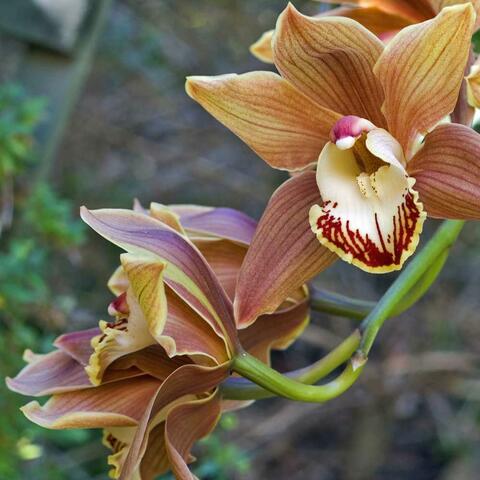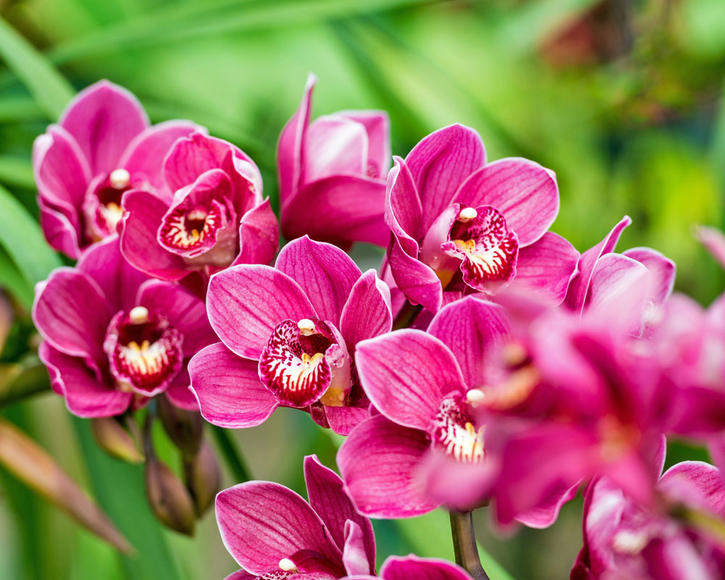Cymbidium Orchid
Big flowers, big requirements: If you feel up to the challenge of the Cymbidium Orchid, you’ll be rewarded with an array of unique flowers. Here’s how to do it.
Factsheet
- Growth type
-
- rhizome
- Growth height (from)
- from 15 cm to 100 cm
- Growth characteristics
-
- upright
- overhanging
- Flower color
-
- purple
- yellow
- orange
- red
- pink
- white
- brown
- multicolored
- Flowering time (month)
-
- January to March
- October to December
- Flower shape
-
- Uniflorous
- terminal
- Flower characteristics
-
- lightly fragrant
- Leaf color
-
- green
- page format
-
- long
- narrow
- Sheet properties
-
- evergreen
- Light
-
- scattered light
- Soil type
-
- gravelly to sandy
- Soil Moisture
-
- fresh
- Lime compatibility
-
- sensitive to lime
- Nutrient requirements
-
- moderately nutritious
- Humus
-
- low humus
- Decorative or utility value
-
- Flower Decoration
- picturesque growth
- Winter Hardness
-
- frost-sensitive
- Use
-
- Bouquets
- Planters
- Winter garden
- Garden style
-
- Pot garden
Cymbidium Orchids owe their name to the shape of their flowers. The lips of the plant are shaped like a boat - “kymbos” in Greek". Cymbidium was then derived from this. The natural forms of the plant, which the genus emerged from, are native to Northern India, Burma and Thailand. But they are also found in Indonesia and Australia. You’ll predominantly find modern hybrids, which have been cross-bred to make them suitable for indoor cultivation. They are available in many different colors and shapes. Some grow to a height of over three feet, while others have a more compact growth habit. Despite the smaller plants being particularly good for windowsills, they actually thrive in temperate conservatories with plenty of space and light. This makes it easier to achieve lower nighttime temperatures – the most important requirement for free flowering, healthy plants.
In terms of their environment, the extremely beautiful Cymbidium Orchids have very specific requirements. But for experienced Orchid owners or enthusiasts, a Cymbidium Orchid can definitely be a great addition and a real gem in their collection.
Cymbidium Orchids, as well as the hybrids sold here, can grow very tall. They can reach heights of more than 3 feet with the flower spike being even higher than the rest of the plant. Mini Cymbidiums remain much smaller at 5.9 to 9.84 inches.
The leaves are green and can grow to lengths of more than 39 inches. They are slender and curve downwards slightly.
The length of the flowering period (winter to spring) is determined by the ambient temperature. If the Cymbidium is flowering, it should be kept at a maximum temperature of 57 degrees Fahrenheit (ideally colder), otherwise the buds will fall off. Conservatories are ideal, the plant will then be in bloom for a good two to three months. Some species give off a pleasant fragrance. Depending on the species, the blossoms can reach a size of 5.11 inches on the long flower spikes. They often need to be supported with a stick.
Did you know? Cymbidium Orchids are particularly good as cut flowers and last at least three weeks in a vase. Provided that you change the water regularly.

Large-flowered Cymbidium Orchids need a location with a cool to mild temperature. Mini Cymbidiums also thrive in the living room at normal room temperature – provided that nighttime temperatures drop by 46 to 50 degrees Fahrenheit. The plants can stay outside in the garden from around May to September, and depending on the weather, even to October. But they do need to be protected from both direct sunlight and rain. The best location during winter is a bright window in an unheated room. A conservatory meets most of the exotic plant’s requirements in terms of temperature, space and light. As already mentioned, a cool room temperature is essential during the flowering period. Once the buds have opened, the temperature can be increased to 61 degrees Fahrenheit. All Cymbidium Orchids favor a bright room, but need to be protected against direct sunlight, especially in summer.
Cymbidium Orchids are often cultivated in rockwool or a peat/bark mix. But you can also use commercially available Orchid soil, just like you do for Phalaenopsis. This is loose and crumbly, and it ensures the roots are well-ventilated.
Cymbidium Orchids need plenty of water during their growth phase. However, you should allow the substrate to completely dry out before you water it again. Once the new leaves and pseudobulbs (an onion-like thickening at the base of the leaves or shoots, also called bulbs for short) have developed, you can water it slightly less – this stimulates flower formation.
If you are leaving your plants outside for the summer, spraying them each day is recommended. This keeps Cymbidiums healthy and prevents infestations of spider mites.
It is best to fertilize Cymbidium Orchids when you water the plant. Use a good dosage of special Orchid fertilizer. Fertilizing the plants every week prevents pests and supports growth and flowering.

Due to their size and rapid growth rate, Cymbidium Orchids need a relatively large planter. A new pot is needed every two years or so; the best time for this is when the fresh shoots have reached a size of approximately 1.96 inches and are forming new roots. Leave the plant in its pot until the roots are sprawling over the edge – quite unusually, they are very happy in tight pots. For the repotting itself, simply shake off and remove the old substrate before putting the plant in its new pot. If the pot is very deep, we recommend putting a drainage layer at the bottom of the container.
Cymbidium Orchids do not need pruning in the true sense of the word. Wilted flowers can be removed and the flower spikes can be trimmed for bouquets.
Older Cymbidium bulbs should be peeled. This prevents rotting and potential pest infestations or fungal infections – and also leaves it looking pretty and tidy. Start with the leaves, cutting off any old and dry ones directly above the bulb. The last remnant is torn in the middle and removed piece by piece from outside to inside.
Choosing you own Cymbidium Orchid really depends on the conditions in your home and how much time you want to devote to it. Here are a few reliable hybrids that you can find in stores.
Cymbidium 'Jocelyn' is a hybrid that opens its wonderful dusty pink flowers for eight to ten weeks in winter. It is vital that nighttime temperatures are cooler and that the plant is kept outdoors in summer.
The 'Antarctic' variety from the "Mini Ice" series is a small Cymbidium orchid that doesn’t need to be kept in a conservatory. It needs plenty of fertilizer and water all year round.

Cymbidium 'Nevada', on the other hand, takes up plenty of space: its inflorescences grow to a height of 59 inches and its golden yellow flowers reach a diameter of approximately 5 inches. It remains beautiful as it ages.
Cymbidium Erythrostylum charms with perfect white flowers that appear in fall and remain on the plant until winter. The species is native to Vietnam.
The green and yellow Cymbidium ‘Loch Lomond’ has been bred for many years. It has a white lip with a red pattern.
A very new hybrid with an unusual color: Cymbidium 'Aurora' from the "Scott’s Sunrise"series has orange blossom.
Plants with more than six bulbs can be easily divided. However, each section should have at least one new shoot and three to four older bulbs. As the roots are very dense and strong, don’t hesitate to use a spade or a hand saw when dividing them.
Unfortunately, Cymbidium Orchids are very susceptible to pests. Thrips, scales, mealybugs and red spider mites are a common occurrence when the plants are grown indoors. When they’re outside in summer, they are often troubled by woodlice, millipedes, ants and slugs. The only way to prevent this is to provide the best possible care and to regularly check the plant, especially before you bring it back indoors.

